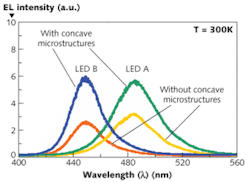Semiconductors that make up an LED have such a high refractive index that much of the light produced by a conventional LED never escapes from the device into the surrounding air. Many approaches have been taken to increase the light coupled out of an LED, including roughening the surface (resulting in uneven light emission) or adding photonic-crystal structures (requiring complex, expensive extra processing steps). The approaches that ultimately win out will, of course, be the ones that turn out to be the easiest, cheapest, and most effective to put into practice.
A group at Lehigh University (Bethlehem, PA) has been experimenting for some time on this problem, for example creating monolayers of glass/plastic microsphere lens arrays that increase light extraction. Now, they have gone one step further by using the glass microspheres not as embedded convex lenses, but as molds to create an array of concave microsurfaces in plastic–making the process simpler and more effective.1
Simulated arrays
The researchers first simulated a 100 × 100 µm gallium nitride (GaN)-based LED with four quantum wells, creating models of the LED both with and without arrays of plastic concave microlenses. The plastic used in the simulation had a refractive index of 1.43 (GaN has an index of about 2.5); arrays were created with plastic-layer thicknesses of 2 and 3 µm, emission wavelengths of 420, 480, and 525 nm, and concave-microstructure diameters ranging from 0.3 to 2 µm.
As the concave diameter increased, the light-extraction efficiency droped, eventually approaching that of planar LEDs. The efficiency was relatively independent of the emission wavelength; for 420 and 480 nm wavelengths at a plastic thickness of 3 µm, the optimum diameter was 0.5 µm, while for an emission wavelength of 525 nm, the best diameter was found to be 0.75 µm.
A monolayer array of glass microspheres was then deposited on a glass slide using a rapid convective deposition technique, in which a solution of spheres in fluid was swept across the slide by a blade. An LED with a 3 µm layer of plastic (PDMS Sylgard 184) spun-coated on it was then imprinted by the microsphere array and the PDMS-coated wafer heated to 80°C for 45 minutes to cure the PDMS. Finally, an ultrasonic bath removed the microspheres.
Electroluminescence measurements of LEDs with and without the PDMS arrays were done for LEDs emitting at 450 nm (LED A) and 490 nm (LED B) at an injection current of 80 A/cm2 and for arrays with a 1.0 µm concave diameter. LED A showed a 1.60 times improvement in output when compared to a planar LED, while LED B exhibited a 1.70 times improvement (see figure).
The researchers believe that if an LED encapsulate were to be fabricated over the microlens arrays, most of the light scattered out by the PDMS arrays would be coupled into the encapsulate, and thus would not be lost.
REFERENCE
- Yik-Khoon Ee et al., Optics Express 17(16) p. 13747 (Aug. 3, 2009).

